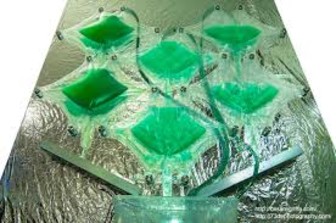Invasive and Noxious Plant Management
These entities will develop and implement Integrated
Past projects funded encouraged the State and the Bureau of Land Management to work together to control, manage and eradicate undesirable invasive species on Federal, State, and private lands.
By working together entire areas are treated to control and prevent the spread of noxious or undesirable plants and other invasive species within the close proximity of public lands.
The Department of the Interior protects and provides access to the Nation's natural and cultural heritage, including responsibilities to Indian tribes and island communities. Departmental goals include resource protection and usage, overseeing recreational opportunities, serving communities and excellence in management.
Program Accomplishments
The State and the Bureau of Land Management have worked together with private and non-federal landowners to prevent, contain, and control the spread of noxious weeds. Because the plants move rapdily from one owner's land to another, joint efforts to eradicate, contain or control noxious weeds reduces adverse impacts on public and private lands and reduce costs to all land owners.
Uses and Use Restrictions
Funds may be used on public, State county, and private lands for approved projects that prioritize and target undesirable plant species or group of species to be controlled or contained within a specific geographic area; describe the intergrated pest management system to be used to control or contain the targeted undesirable invasive species or groups of species; and detail the means of implementing the integrated pest management system, define the duties of the Federal agency and the State agency in prosecuting that method, and establish a timeframe for the initiation and completion of the tasks specified in the integrated management system.
Eligibility Requirements
Applicant Eligibility
State and local governments.
Beneficiary Eligibility
Anyone/General public.
Credentials/Documentation
None.
Aplication and Award Process
Preapplication Coordination
Coordinate cooperative project proposals with Bureau of Land Management local State or District office for more information and local requirements.
This program is excluded from coverage under E.O.
12372.
Application Procedures
A Standard Form 424, Application for Federal Assistance, Standards Form 424A, Budget Information for Non-Construction Programs, Standard Form 424B, Assurances for Non-Construction Programs, and a written proposals should be submitted through Grants.gov or via hardcopy to the project office and include: a title, objectives, timeframe, and a budget breakdown as specified in the funding opportunity announcement. No State plan is required with this application.
Award Procedures
Projects are reviewed at the Bureau of Land Management State and District Office level and funding recommendations are made through the State's annual work plan. Final budget approvals rest with the State Director.
Deadlines
The deadline will be published in the Grants.gov announcement.
Authorization
Federal Noxious Weed Act of 1974, 7 U.S.C. 2814; Watershed Restoration and Enhancement Agreements, 16 U.S.C. 1011, Public Law 104-208, Section 124, as amended, Public Law 105-277, Section 135; and Executive Order 13112, Invasive Species, February 3, 1999.
Range of Approval/Disapproval Time
Most awards are anticipated within 90 days or less after the announcement closes.
Appeals
Not applicable.
Renewals
Not applicable.
Assistance Considerations
Formula and Matching Requirements
This program has no statuatory formula requirements. However, applicant's matching funds are encouraged and those projects are more likely to be funded.
Length and Time Phasing of Assistance
No specific retrictions for most projects, however, most projects are awarded for a five year period and funded on a year-by-year basis and funds are expended during a particular fiscal year.
Post Assistance Requirements
Reports
Recipients of funding are required to submit quarterly financial status reports using Standard Form 269, Financial Status Report, and quarterly, semi-annually, or annual performance reports 30 days following the end of the reporting period.
Final performance and financial status reports are due 120 days after the end of grant performance.
Audits
In accordance with the provisions of OMB Circular No. A-133 (Revised, June 27, 2003), "Audits of States, Local Governments, and Nonprofit Organizations," nonfederal entities that expend financial assistance $500,000 (for fiscal years ending December 1, 2003) or more a year in Federal awards will have a single or program-specific audit conducted for that year. Nonfederal entities that expend less than $500,000 (for fiscal years ending after December 1, 2003) a year in Federal awards are exempt from Federal audit requirements for that year, except as noted in Circular No. A-133.
Records
Records are required to be maintained for three years following submission of the final expenditure report.
Financial Information
Account Identification
14-1109-0-1-302.
Obigations
FY 07 $2,718,000; FY 08 est $2,800,000; and FY 09 est $2,900,000.
Range and Average of Financial Assistance
The previous fiscal year average was about $20,000.
Regulations, Guidelines, and Literature
Information about the Bureau of Land Management invasive and noxious plant management program can be found at http://www.blm.gov/wo/st/en/prog/more/weeds.html.
Information Contacts
Regional or Local Office
See Catalog Appendix IV for addresses of Bureau of Land Management State Offices.
Headquarters Office
Senior Weeds Specialist, Division of Rangeland Resources, Bureau of Land Management, 1849 C Street, MS: 201LS, Washington, DC 20240. Telephone: (202) 452-5084.
Criteria for Selecting Proposals
General criteria used to select assistance proposals are based on their direct relationship to federal lands and a balanced review including relevance to program objectives, merit and cost effectiveness.
Social Entrepreneurship
Spotlight
When it Comes to Social Enterprises, Failure is the Best Platform for Innovation

In the world of social enterprises, failure is a cringe-worthy moment nobody wants to talk about. But, social entrepreneurs can benefit from their failures.

